December 6th, 2013 §
Another olive egger pullet has come online. Yesterday I got two olive pullet eggs, and I figured out that their mother Dahlia is responsible for the big brown egg. She’s setting a good example!

These little olive eggs are so amazing. They’re like the eggs of some exotic species. And today I got one more! The pullets are twenty-one weeks old this week. Eventually the pullets should produce full-size eggs—these are just their starter eggs. Thus I am especially appreciating them because I know they are a fleeting phenomenon.
Something I never knew before I had chickens is that a hen will consistently lay eggs of basically the same shape and color, with the same amount of speckling. If you pay attention, this makes it easy to know which bird is laying which eggs, and how often, and gives you a good idea of a particular hen’s productivity. For example, I can tell from looking at the photo above that different pullets are laying the olive eggs, even if I didn’t know they were both laid on the same day, as one egg is browner with speckles, and the other is a clear, lighter olive. And the first egg I got this week was laid by the pullet that produces speckled olive eggs.
December 3rd, 2013 §
I had a completely unexpected surprise today as I was feeding the chickens. I glanced into their nest box and saw this:

Ever since the girls quit laying for the winter—many weeks ago—I’d stopped checking their nest box for eggs. But it turns out that even without any supplemental light, and headed into the darkest days of winter, at least two chickens are making an effort. One, laying the large brown egg, is either Dahlia or her Black Copper Marans sister. And the other laying chicken is a homegrown olive egger pullet, which is a total surprise as the chicks were born so late this summer that I hadn’t expected any of the four young pullets to lay before next spring.

This little olive pullet egg is the first egg from a chicken born and raised right here on Bonafide Farm. She’s a second-generation Bonafide bird, and a science experiment begun two years ago when I raised her Wheaten Ameraucana (blue egg-laying) and Black Copper Marans (dark brown egg-laying) parents with the hope that their genes would combine to produce a chicken that lays an olive egg.
And today, with this first beautiful olive pullet egg, I can claim success. Well, as much as one can having not actually laid the egg myself!
For more on how this pullet came to be, head on back to July 2013…
September 3rd, 2013 §
What happened to those damp little fuzzballs? Nothing remains of the chicks but their little peeping noises, which they still make when they aren’t busy practicing being grown-ups, crowing, and mating their siblings.
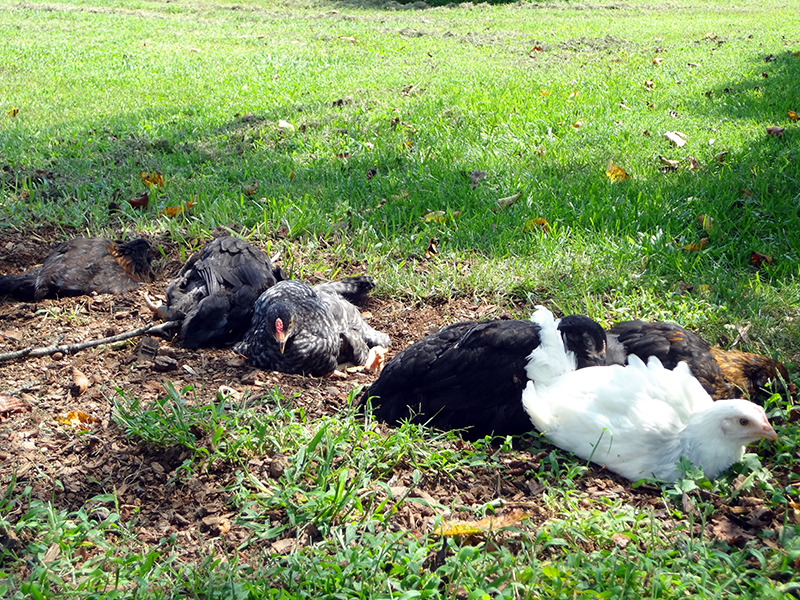
The chicks are now eight weeks old, and they are miniature chickens in most regards. This week I’ve let them find their own way out of their brooder coop and out of the garage into the wild world. They stick close to the bushes, dust bathing for hours in mulch, but each day they venture a bit further from their comfort zone. It’s wonderful to watch.
It looks like I have two cockerels: Griz, Oregano’s baby, and a Black Copper Marans/Wheaten Ameraucana mix. One thing I’ve really noticed is how much more flighty the chicks with the Black Copper Marans blood are. Makes sense, as their parent hens are the least docile of all my birds. Here’s the BCM/Wheaten Ameraucana cockerel, in front, with Griz behind, then the pretty black pullet hatched from Lilac’s egg, and finally a BCM/Wheaten Ameraucana pullet in back.
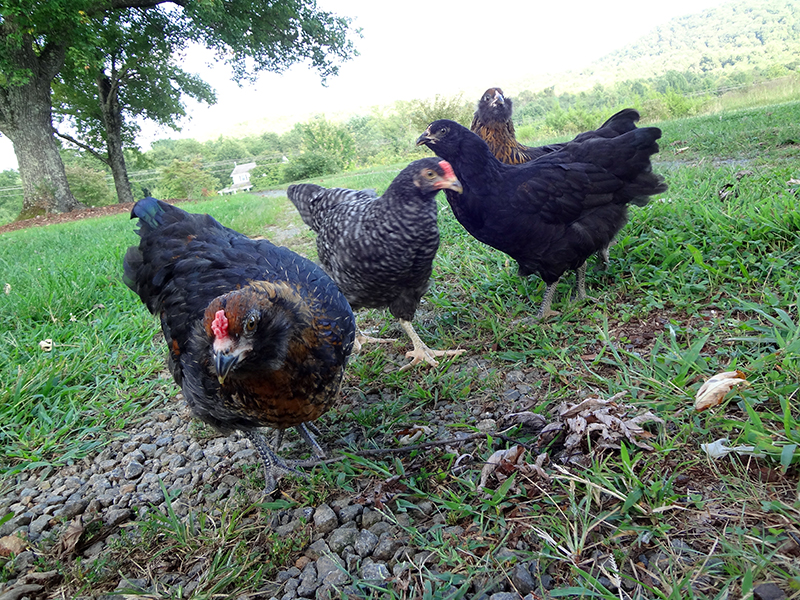
The homegrown birds all, except for Griz, have the cute facial feather tufting that comes along with their Wheaten Ameraucana blood. Interestingly, even though Griz’s father is a Wheaten Ameraucaua, he does not exhibit this feathering. Instead he looks like a straight-up Cuckoo Marans, which is blood that came from his mother’s line. So interesting to see genetics in action. Meanwhile, Griz learns just how palatable slippers are.
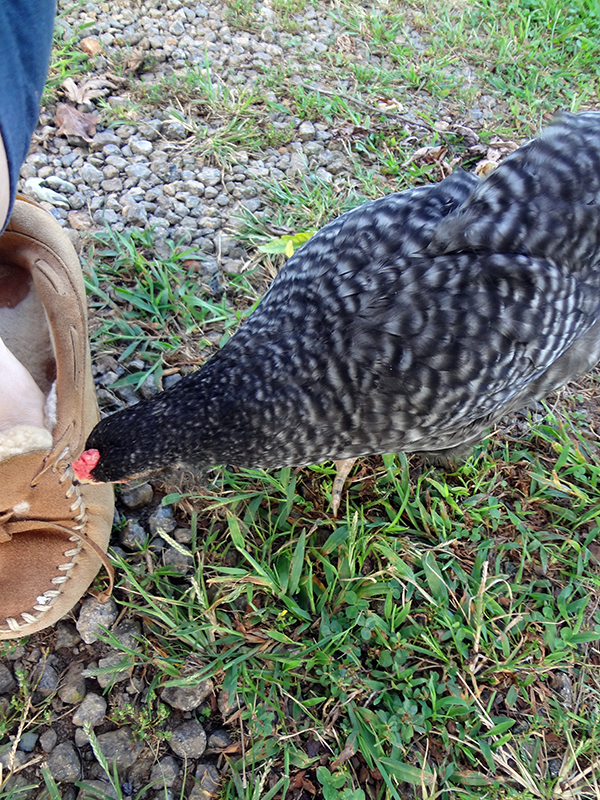
The white Coronation Sussex chick is, I believe, a pullet. Thank goodness. She is the sweetest of all six babies, always the first out of the coop and very amenable to being handled. Her lavender feathers are growing in around her head and tail, and I think she’s just so pretty. I have named her Calla.
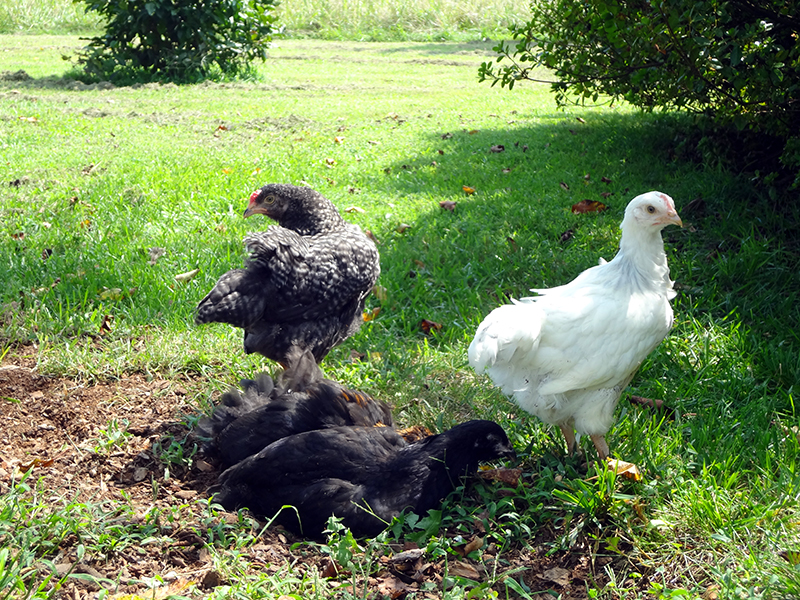
None of the other birds are named yet. I will have to see what comes to me. I also have to get Griz and the other young cockerel up on CraigsList soon. Hard to do because the birds are so cute right now—just perfect little mini chickens. But mini chickens will soon be full-blown roosters, and three on this farm is two too many.
The big chickens have met and mingled with the chicks. It’s gone okay, with the expected bullying as the older birds show the younger birds their place. Here’s Cora landing a squawk-inducing peck on a chick, while the other babies bunch up for safety and Griz tries to decide whether to be a man.
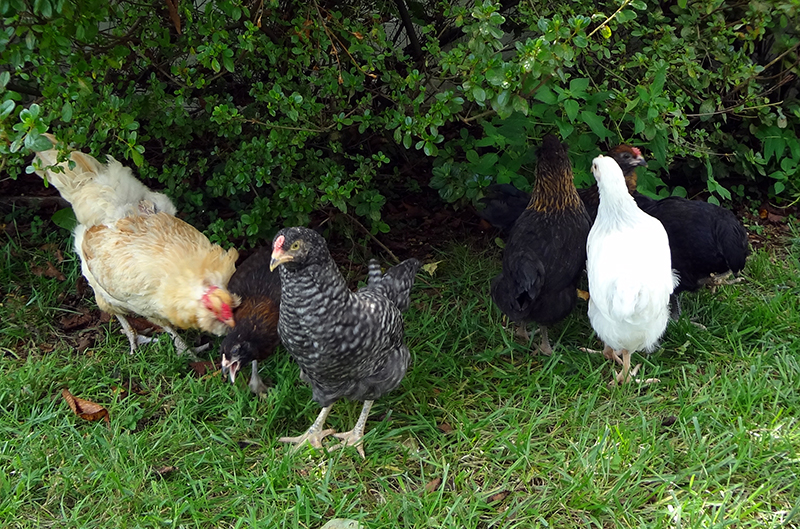
As of last night, Dahlia has rejoined her flock. It seems to be going okay for her. I bet she’s glad to be rid of these increasingly active babies in a small brooder coop.
Fifteen birds running around here is a lot, but I kind of love it. If chickens weren’t so messy, and their food so expensive, and if we didn’t have to go through winter when free-ranging isn’t as easy or safe, I would have zillions of chickens.
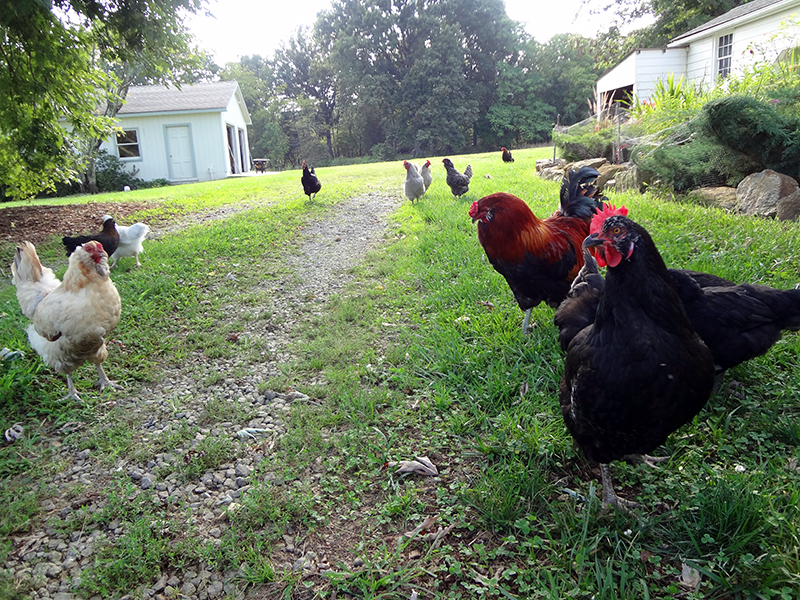
July 26th, 2013 §
I had a lightbulb moment today when I realized that there was a way I could use my chickens to control insects in the garden…without sacrificing my plants or produce. I’ve been wanting to let the pest-eating power of my chickens loose in the garden, with hopes that they would attack the harlequin bugs on my kale, and the Mexican bean beetles on my beans. But, of course, when I let the flock in for a trial run they went right to my ripest tomatoes and dug in. They got a few good mouthfuls before I chased them out, and on their way they scratched the heck out of some smaller plants.
I’ve read that some people use bantams (mini chickens) in their gardens to limit the destruction from scratching, and yet other people suggest that Silkie chickens, which have feathered feet, are gentler as they scratch. I’m lacking in the bantam and Silkie departments, but I do have some very mini chickens of my own—the chicks! I knew that with their tiny size they’d be gentler on the plants than the full-grown birds, and being growing babies their appetites just don’t end.
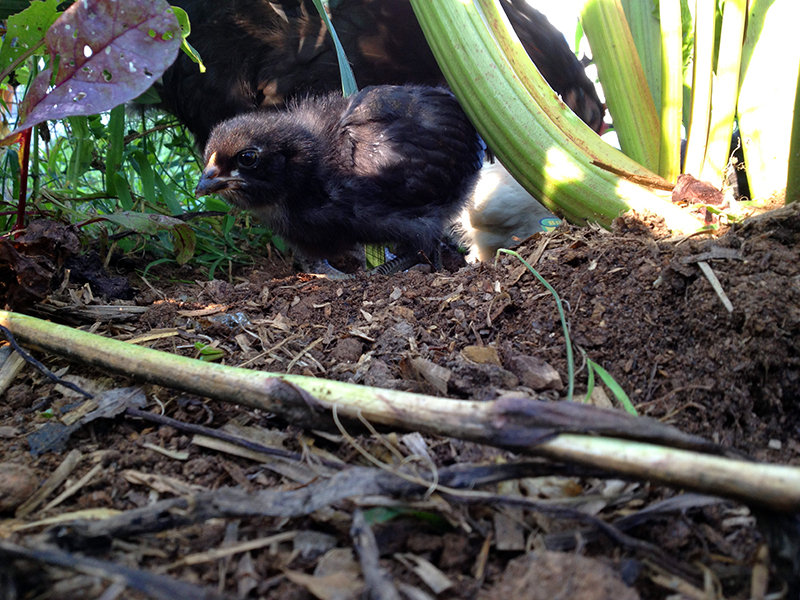
Of course I’d still have to keep the chicks, and their mother, away from the tomatoes. I erected a hasty barricade from a couple of pieces of chicken wire held to the garden posts with zip ties, and then went to fetch my arsenal from the broody coop in the garage.
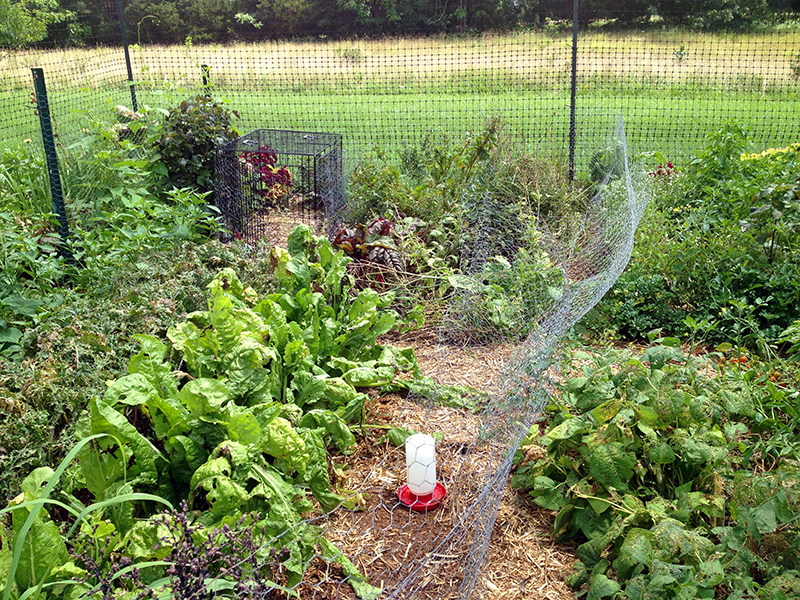
Dahlia’s relief was palpable when I released her into the fenced-off garden section. After a month and a half of living in small coops, and with half a dozen busy babies, I could tell she was dying for some room to stretch her wings. She scratched in the straw, and then lay down to luxuriate in the cool soil with the hot sun on her wings. Two of her chicks immediately imitated her basking behavior, which almost made me fall over from the cuteness.
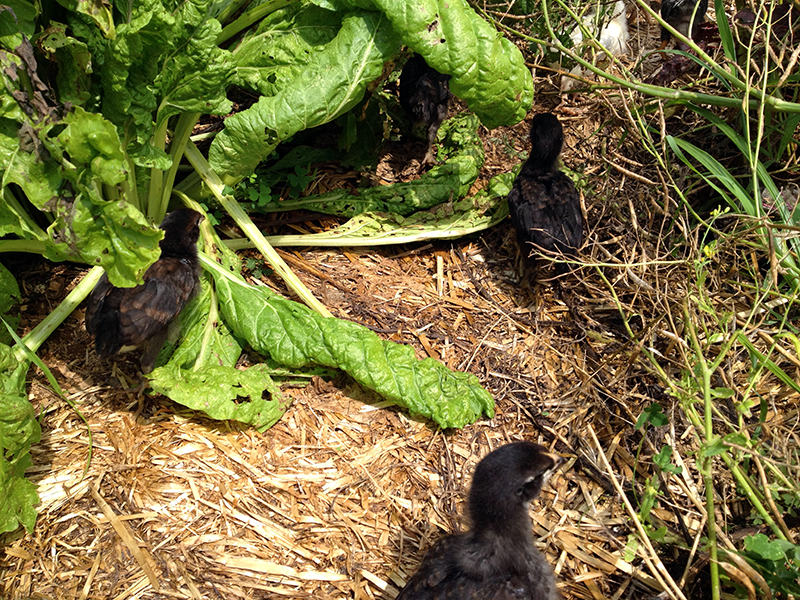
Dahlia and her six chicks spent about eight hours in the garden today. Each time I checked on them they were busy scratching and searching for bugs, sticking close to Mom. They spent a long time under the pest-infested kale, which was great to see. The rest of the flock even came around for introductions, which I hope will help ease things when these babies need to join the adults. After only raising chicks in brooders, it’s a real treat to see natural chicken rearing in action.
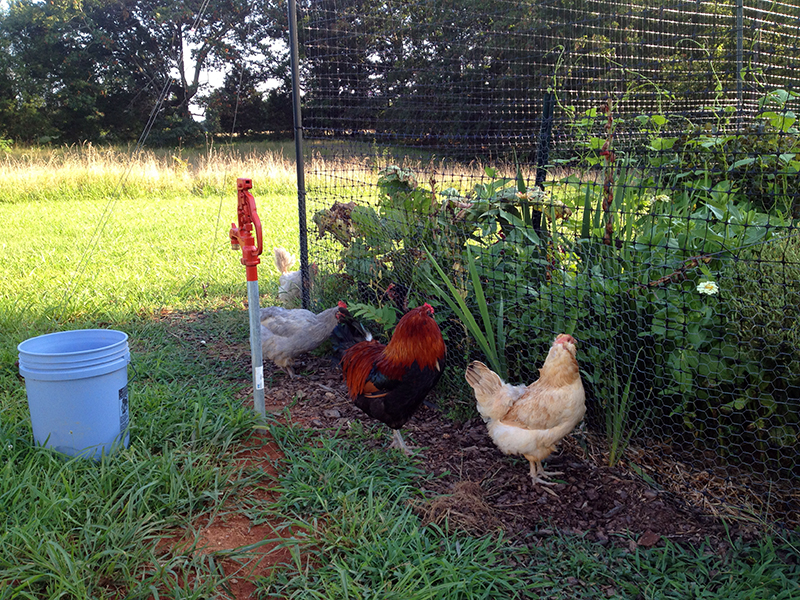
Around sundown it was time to collect the family to return them to the safety of the garage for night. Now this was a hilarous undertaking. I am glad that the only creature around to witness was my dog, and he didn’t judge. I prowled amongst the vegetation, grabbing chicks. I put the chicks in to a five-gallon bucket to carry them back to the garage, but of course they’re now big enough that they easily fly up to the lip of the bucket and jump out. Each time I’d catch and add a chick, one would fly out and go running for its mother. It was a ridiculous chick chase, soundtracked by Dahlia clucking in concern as each baby was lifted airborne.
Eventually I got all the babies corralled and Dahlia tucked under my arm for our journey home. An ungraceful ending notwithstanding, I think it was a good day out of the chicks, and a big help for the garden.
July 24th, 2013 §
The chicks are growing by the hour, and their new trick is to jump on Dahlia’s back and ride around a bit before sliding/flying off. She is amazingly patient with these constant assaults, which are probably way more cute to me than they are to her.
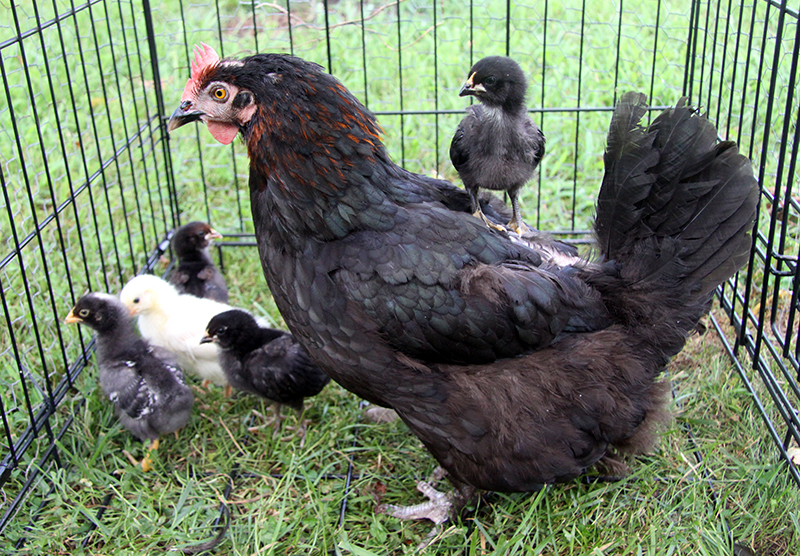
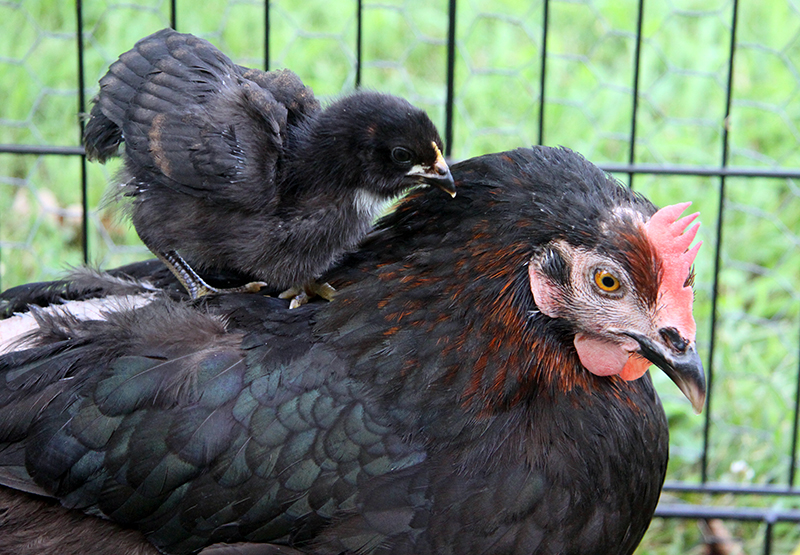

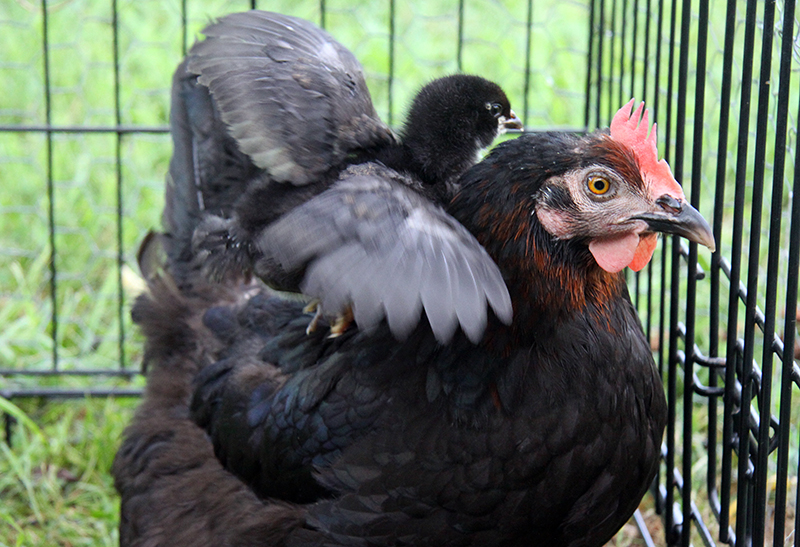
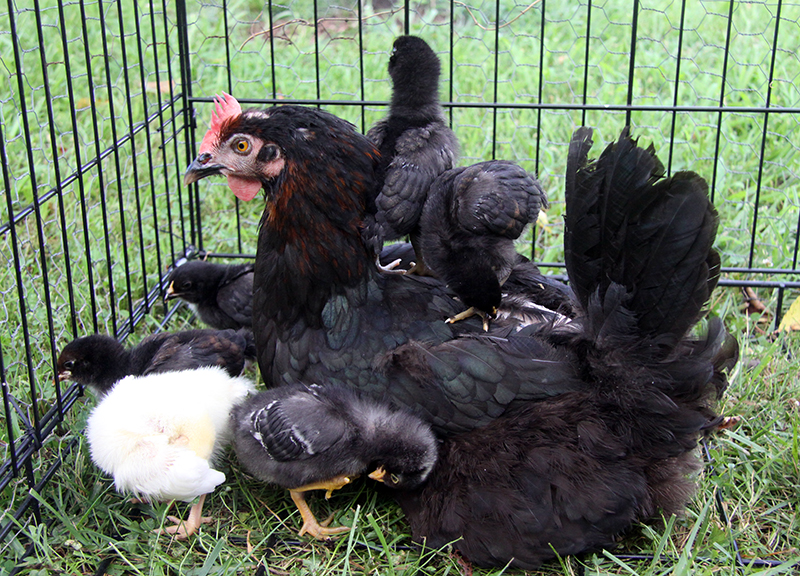
All this action shows me the chicks are ready for new adventures. On Saturday night I wrapped Tuckers’ puppy crate in chicken wire to make an escape-proof pen, and took the chicks outside for their first real exposure to grass and dirt. I’ve had then out every evening for a bit, and it’s neat to watch them learn how to scratch, hunt bugs, and eat clover. It’s amazing how much the chicks change and grow from day to day. Just two weeks old and they’re well on their way to being big chickens.
July 16th, 2013 §
Enough of bloody flock power struggles. Let’s talk about the happy family living in the broody coop in the garage. Dahlia is a very calm and patient mother, and protective. She flew out of the coop last night when I took one of her chicks out to hold and she heard its distress cries. She’s doing a great job with her six chicks. They’re growing and changing by the day, and are already feathering out. It’s exciting to see a lot of copper brown in the new feathers of the black olive-egger chicks.
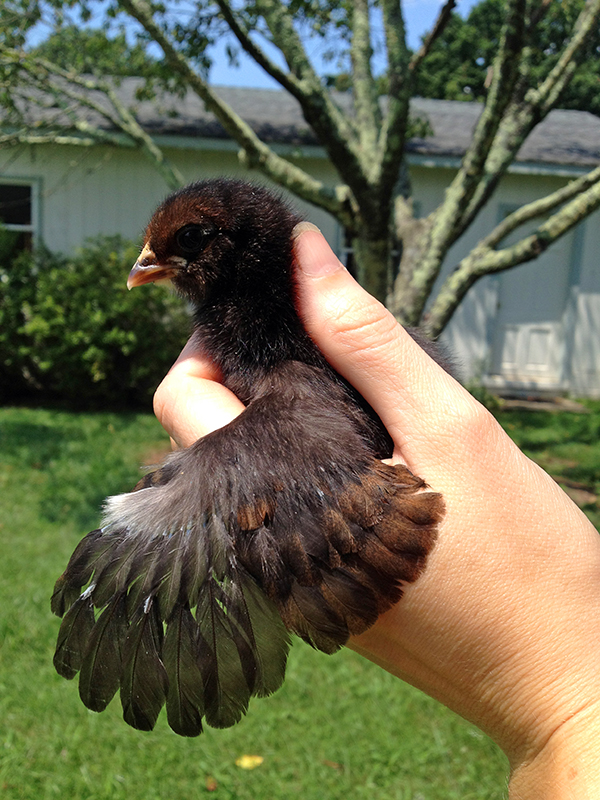
I am not sure if they will be any indication of the final coloration of the birds as adults, as coloration changes each time the chick molts. But it would be neat to have some brown hens—I don’t have any in the flock now.
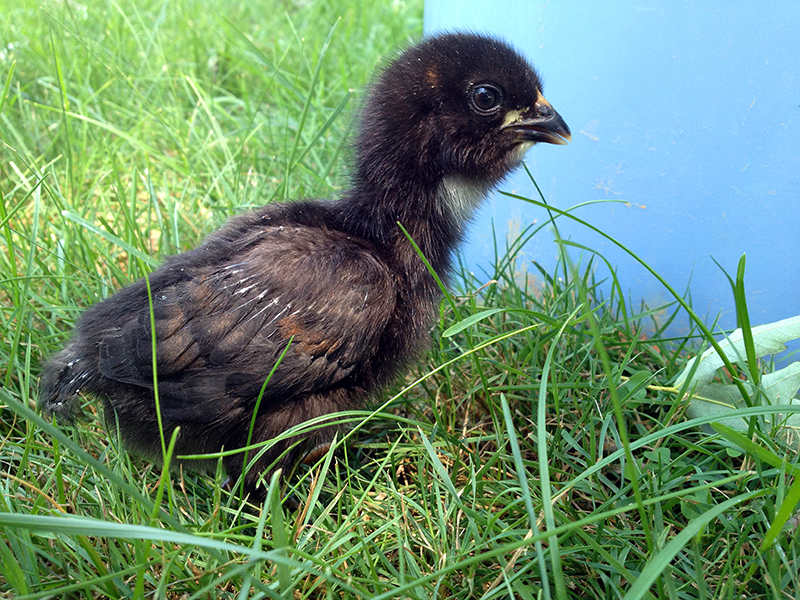
Some of the chicks still have their dried up umbilical cords attached. I never knew birds had umbilical cords until I saw them on the guineas that Iris hatched out last summer.
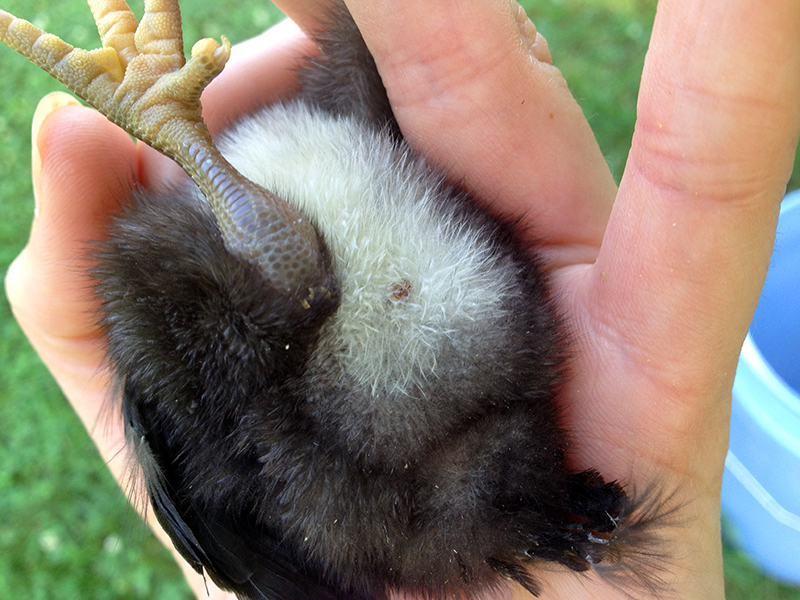
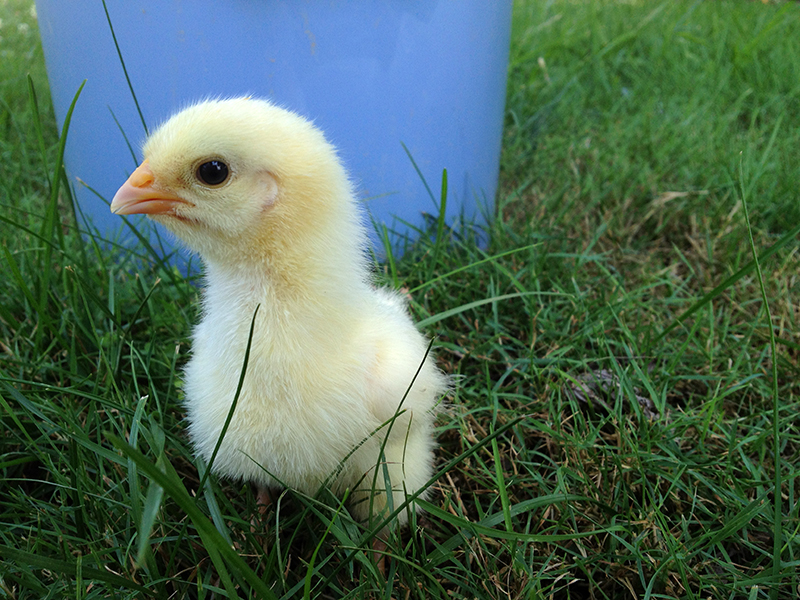
Here’s the sole Coronation Sussex chick. My $20 chicken (six hatching eggs cost $20, and this is the only bird I got out of them). Thankfully these birds are rare enough around here that if it’s a cockerel I should be able to sell him for at least $20.
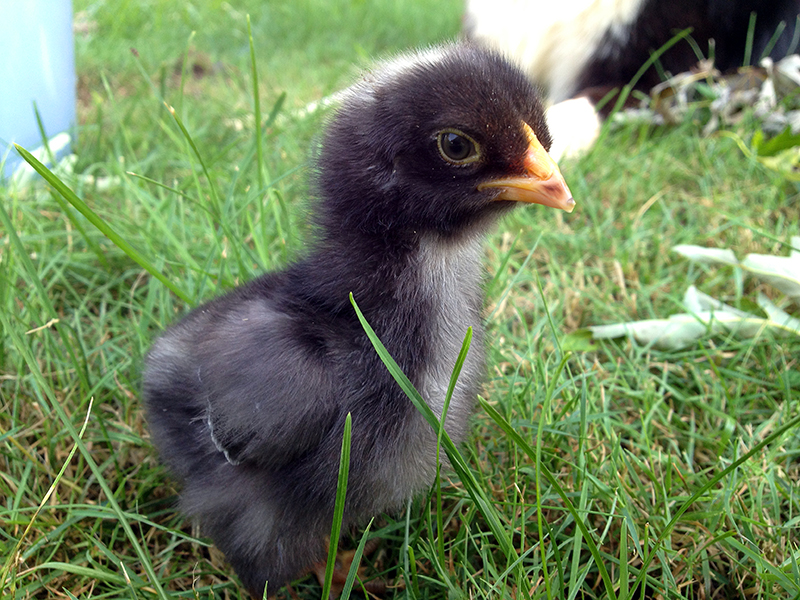
This is Griz, the only chick out of my barred olive egger Oregano and the chick whose egg survived car trips and refrigeration at my brother’s house. I let my brother name the chick. He picked Grizabella, but when the chick was born a boy the name got shortened to something more masculine. The white barring is just starting to show on his wing tips, and he’s got a bit of copper color to his head (which makes me think this coloration traveled in on my Wheaten Ameraucana rooster’s genes, as the black chicks have it too). But who knows!!? The neatest thing about making these breed crosses is seeing what they turn out to look like.
July 10th, 2013 §
There were no new babies born overnight, but around noon today I found a broken open Coronation Sussex egg. The embryo inside was well developed but still had a lot of yolk, so I know it wasn’t ready to be born. It was the egg that Dahlia chucked out of the nest on the first day of the hatch. Perhaps she did that because the embryo had died, or maybe it was out of the nest long enough to chill and stop developing. We’ll never know.
There was a Black Copper Marans egg in the process of hatching under Dahlia. It seemed to be struggling a bit, but I left it alone. When I came back hours later there was a new chick.
Once the chick had dried, I inspected it. Unfortunately it was born with a severe birth defect. It has only one eye, and its beak is misaligned.
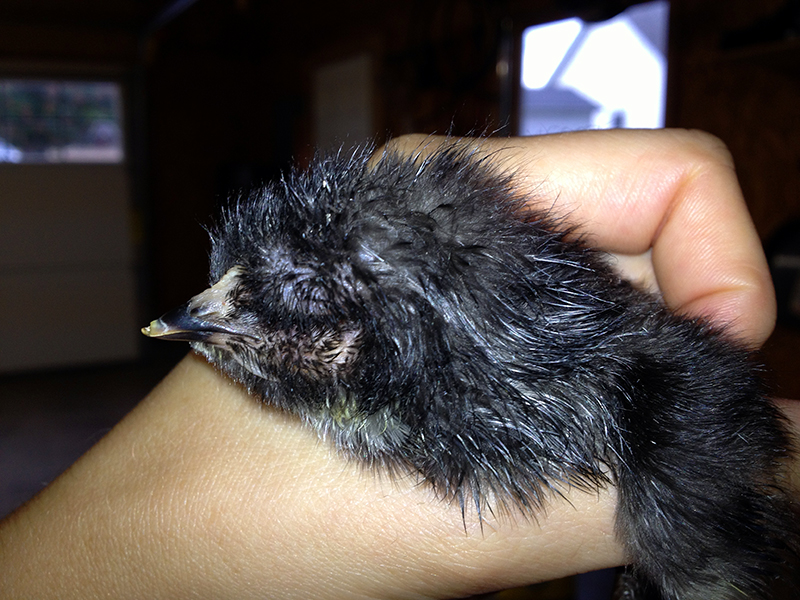
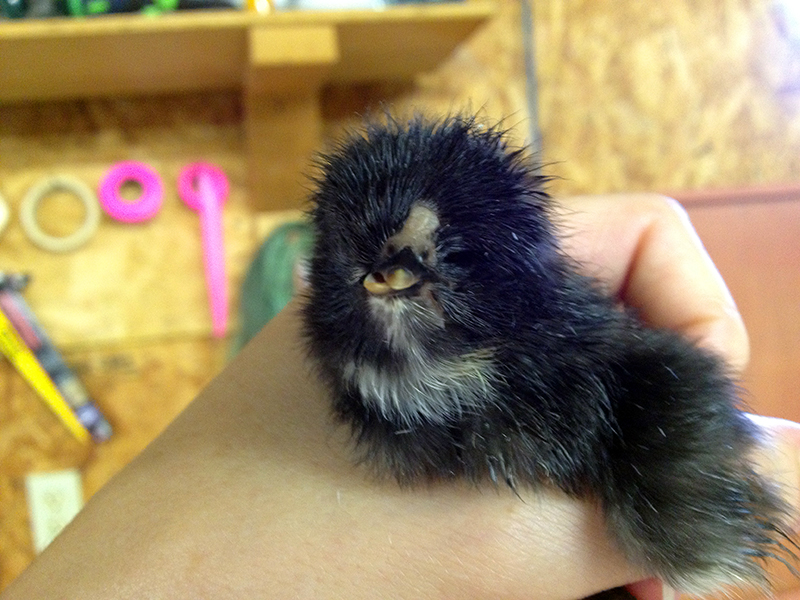
I suspect that there is no sight in its one eye, as it struggles to open that eye and doesn’t seem to respond to any visual stimuli.
I did some quick research and the prognosis isn’t good for a bird born with this defect. Some people can keep them alive with careful attention to making sure the bird gets enough to eat, but most people cull chicks born like this. That is what I plan to do.
The deformed chick, did, however, give me a good opportunity to get all six healthy chicks under Dahlia. I knew going into this that if I had just a few chicks, I would try to combine them under one hen. It didn’t make sense to double the work and cleanup of managing two coops of babies, and I knew that the older the birds got the more trouble I would have when it came time to combine both groups of babies. As I already know how potentially fraught introducing new birds to the main flock is, I wanted to minimize one extra step in the development of a new pecking order.
I chose to take the chicks away from Oregano because of the two birds, she seemed the less serious about mothering. She had pecked at the toes of the Coronation Sussex baby when it was brand-new, and today she was off the nest several times during the day, eating, drinking, and trying to dust bathe in the pine shavings. Not that one can blame her! Perhaps she knew the hatch was done and was trying to get her babies to follow her out to food and drink, but I didn’t get that sense from her.
I was stressed to put Oregano’s three chicks under Dahlia, but I did it one at a time and she didn’t bat an eye. The chicks dove right under her breast like they’d always been there, and there’s been no looking back. In fact, she led her babies off the nest this afternoon, leaving the deformed chick in the nest.
I took the unhatched eggs from Dahlia’s nest and added them to Oregano’s along with the deformed chick. I figured she’d go less crazy if she had a chick under her than if she had nothing and could hear chicks next door. But who knows, maybe she wouldn’t care? Anyway, the plan now is to give any remain eggs another day under Oregano to try to hatch, though I doubt any will, and then return Oregano to the main flock. Which might be tough if they see her as an intruder instead of a flock mate. Geez—managing these birds can really be a pain!
But if I get Oregano back with the flock, I should be in the clear. Dahlia can raise six chicks for as long as she likes, and I will deal with whatever comes next when it arrives. The good news is the six chicks now with Dahlia have spent the afternoon learning to eat and drink.
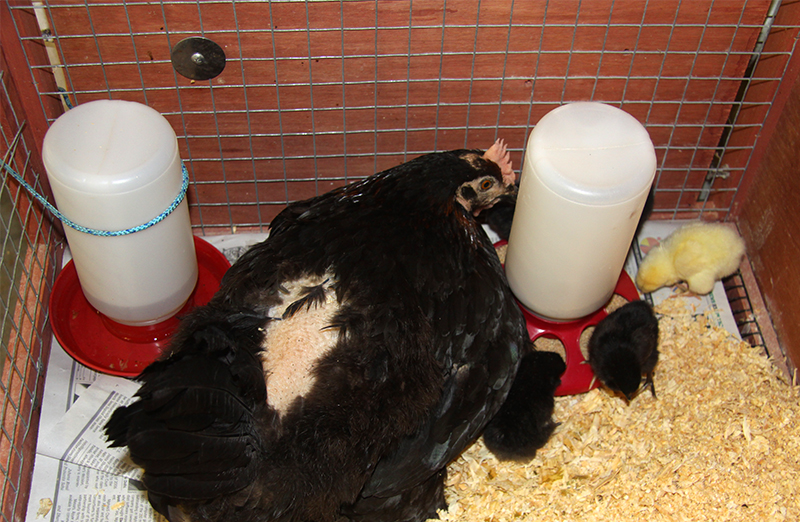
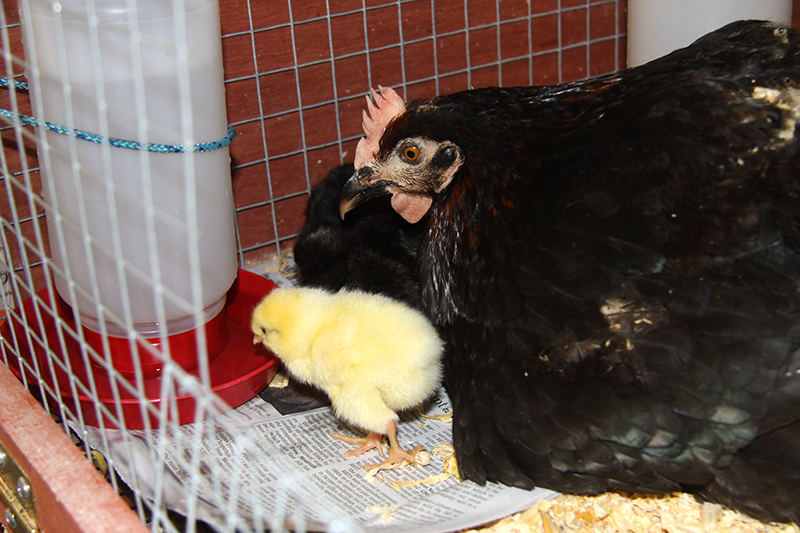
They are very active in the coop, pecking at everything including their mother’s comb (you can see a little blood spot in the photo above), wattles and even eyeballs, and seem healthy and happy. They run around, and when they are tired they dive into their mother’s feathers for a nap. Can you spot the stowaway?
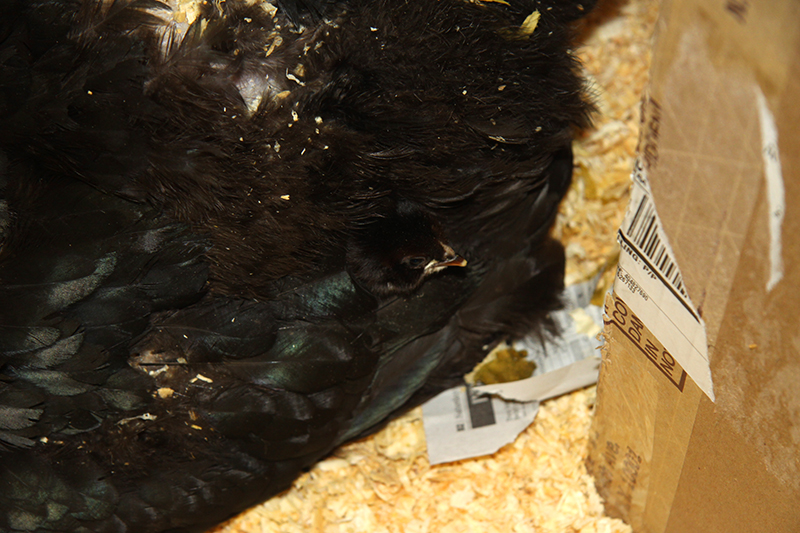
July 9th, 2013 §
There are new chicks, hatched early this evening, under both Dahlia and Oregano. Both are babies from Black Copper Marans eggs. Now each hen has three live babies, for a total of six on the ground. Oregano had one baby that pipped this evening, but it died before making it out of the shell. When I investigated, its yolk hadn’t yet been absorbed. I am starting to think the hot temperatures have affected this hatch, but that’s just a hunch and not substantiated yet with any research.

The chicks that were born last night are very active, hanging out at the front of the next box, pecking at shavings, and interacting with each other. Here are the yellow Coronation Sussex and the barred olive egger/wheaten Ameraucana boy.

They must be starting to think about food. Perhaps tomorrow they will take their first excursion out of the nest box. I am sure both mothers are also ready to get out of the nest. Notice how pale and dehydrated their combs and wattles are. Incubating eggs takes a lot out of a hen as they barely eat and drink just enough to keep from dying. They’ve both lost a bunch of weight—when I feel their chests all their breast muscle mass has shrunk away on either side of the keel bone.
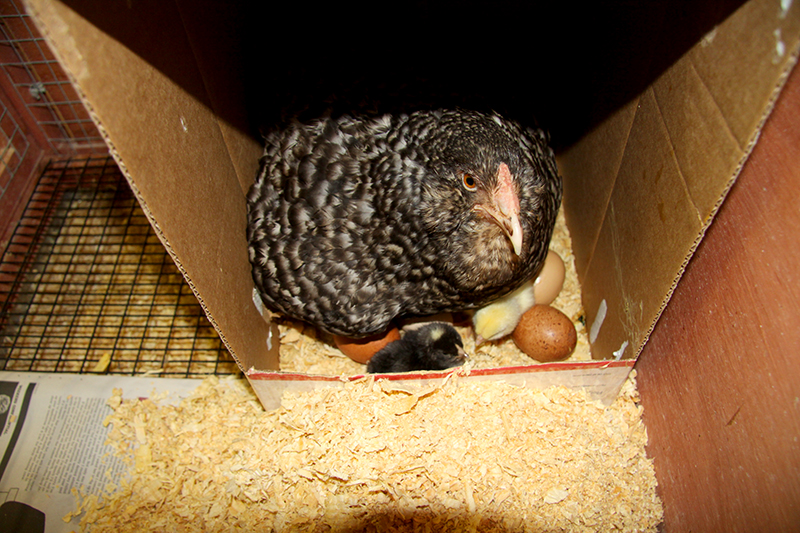
I find it interesting that when the guinea keets hatched last summer, they were way more active, way sooner than the chickens. The guinea keets were still wet from hatching and they’d already begun running out of the nest box. The chicks seem to be rather limp until they fluff up and find their legs. This little one under Dahlia has favored this front corner of the box all day. The chick has a few copper colored feathers, the same tone as mama’s, around its head and sides.
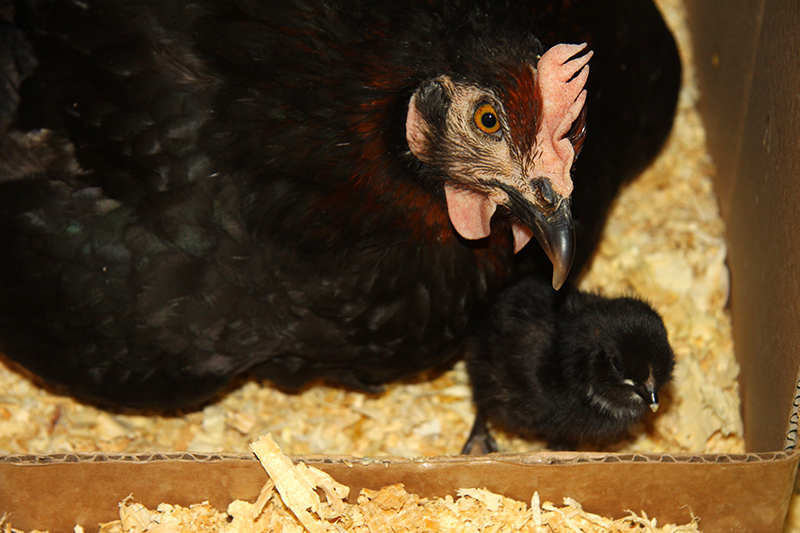
I suspect we might be done with this hatch. There aren’t any more pipped eggs, and nobody cheeped when I tapped on their shell. But we’ll see what the morning brings. I am ready to be done with this hatch phase, with its attendant death and stinky ooze, and on to seeing darling little fluff balls running all around the coop learning to be big chickens.
July 9th, 2013 §
At 8:00 a.m. I went out to check on the chicks. I heard peeping when I opened the garage door, so I knew there were babies somewhere!
Under Dahlia, two black chicks were just about all dried and fluffy. One came from a Black Copper Marans egg, which makes it an olive egger, and the other chick is Lilac’s baby. I saw one pipped egg but didn’t check them all.
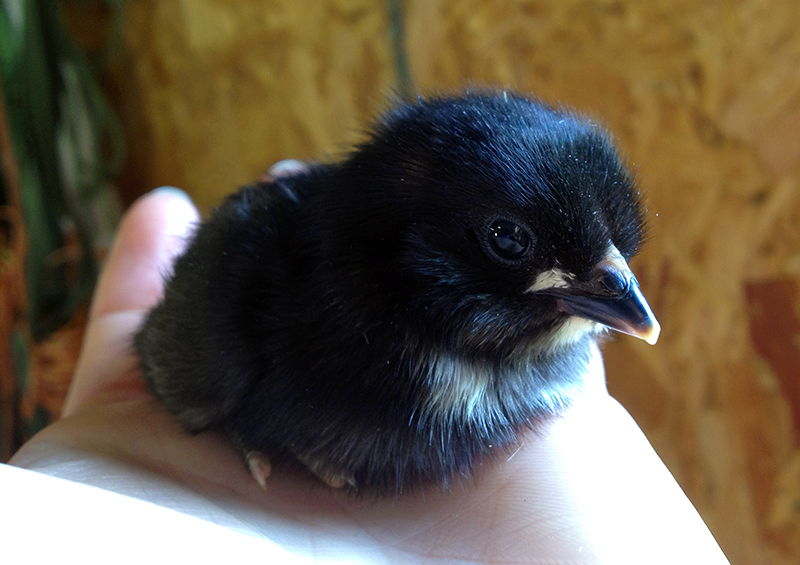
Under Oregano, the barred olive egger, there were two hatched chicks.
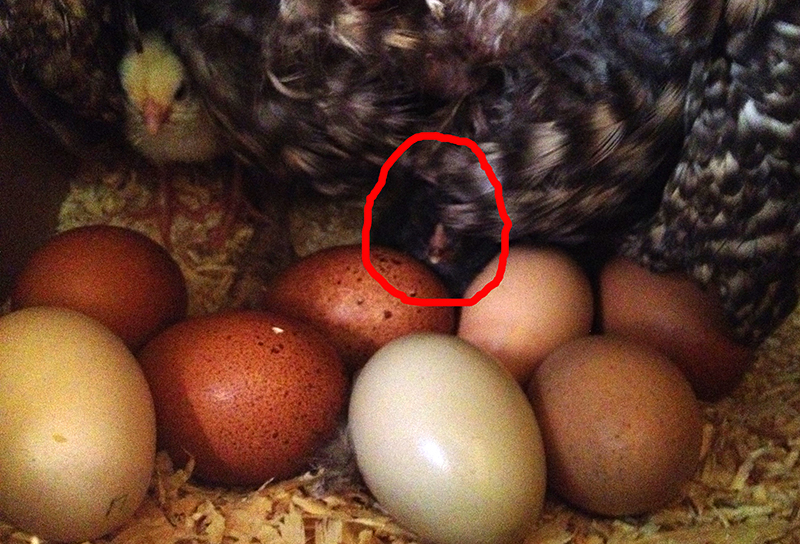
First up is a yellow Coronation Sussex baby!
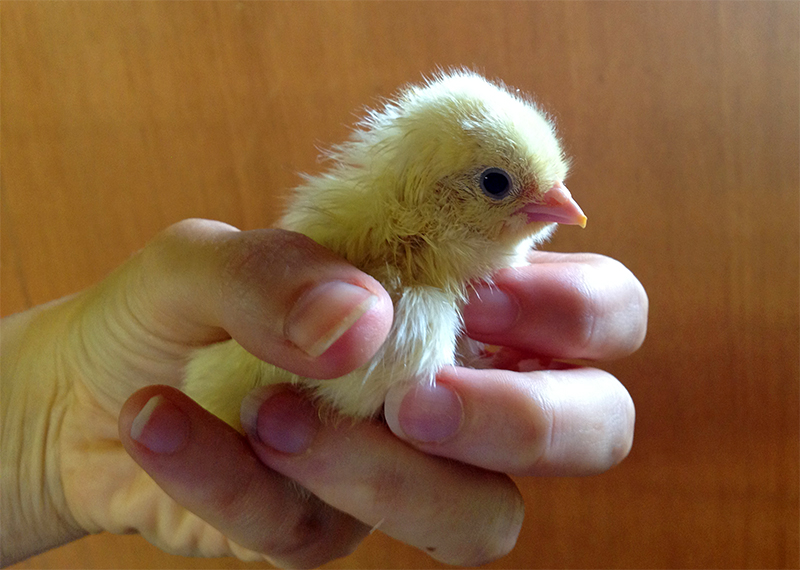
This is pretty exciting. And Oregano’s own egg, the one that journeyed to a Richmond refrigerator and back, had hatched during the night.
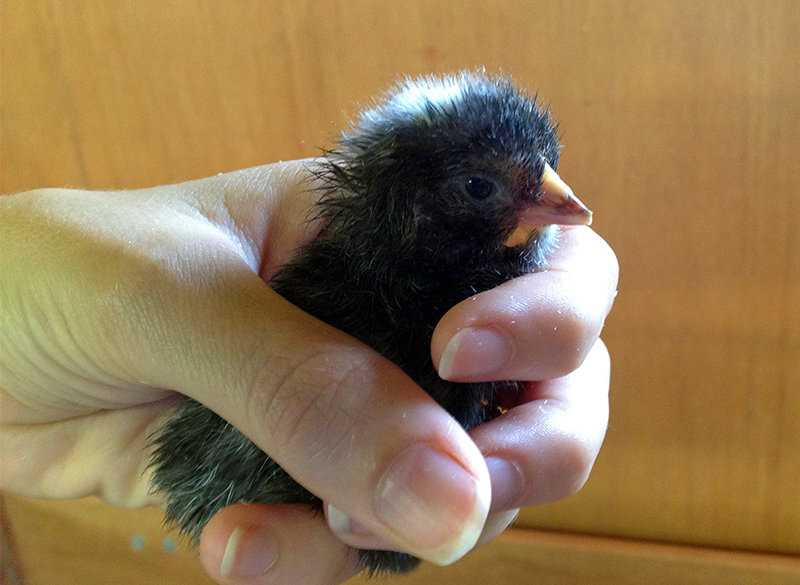
Unfortunately I think it’s a boy, as it has a white spot on its head, a sex-linked characteristic of barred breeds. Too bad I won’t get a chance at a super green egg layer this time around.
Meanwhile, here are the chicks’ empty eggshells. From top, the Coronation Sussex, then the barred olive egger, then Lilac’s egg, and finally a Black Copper Marans egg.
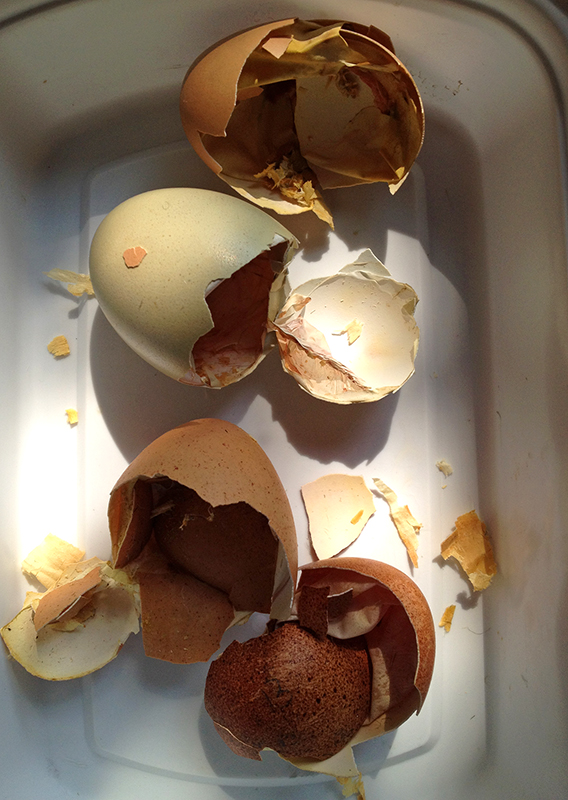
I saw another pipped egg in Oregano’s nest, so I left them in peace to continue hatching. There may be more babies to come, we’ll see.
July 8th, 2013 §
When I got Tuck in from his evening constitutional, around 10:30 p.m., I checked the nursery. There was a lot of action under Dahlia, lots of peeping and I saw a black chick partially emerged from its egg. Of course my phone battery was dead, so after it had charged up I headed back out, around 11:00 p.m., in hopes of getting a photo for you.

A chick! A real, live, healthy, vigorous chick! It obviously had a nice, quick, clean hatch, and was moving around like crazy. In the light of the flashlight, which I held in my mouth to take these photos, it bobbed and ducked and cheeped and burrowed deeper under Dahlia. She seemed to regard it with benign curiosity. Like, what is that? It’s a good thing she will have the whole dark night to get used to the idea of being a mother. Which she will be several times over, if the noises on her nest are any indication.
You can also see in the photo above the egg, on the right, that was pipped in my last post. Not too much development there.
Over in Oregano’s coop, it was much quieter. But, her egg, the olive egg, was definitely progressing. This is somewhat amazing as this is an egg that I put in a carton, carried in a warm car down to Richmond to give to my brother to eat, where it spent several days in a refridgerator before I realized Oregano had gone broody and ceased laying. This egg, and another that traveled with it, plus one I still had at home, were her only hope of biological offspring. So my brother carefully packaged the eggs for a return trip via my dad to Charlottesville, where I placed them back under their mother. One olive egg disappeared during incubation, and the other came up clear when I candled it. Thus I had zero expectation that through all this jostling, temperature change, etc., this egg would hatch, but here it is, tonight, with a peeping baby inside.

And here’s another egg, still pipping and making progress:

All eggs went immediately back under their mothers, and I came in to write this post before bed. I’d be lying if I said my heart didn’t stop seeing that healthy, wet baby under Dahlia. I am not the fainting type, but I felt lightheaded and swoony. I guess that’s what happens when you’re face to face with brand-new, much-hoped-for life. I could only imagine what it would feel like to see one’s human baby. If my reaction to new-born chickens is any indication, am not sure my heart would survive the crush of emotion.
I hope that the first check in the morning reveals nests full of fluffy, healthy, hungry chicks. That is my dream for tonight.








































